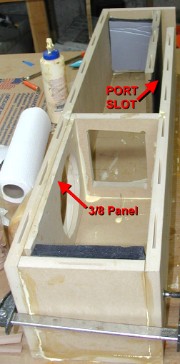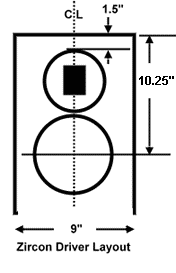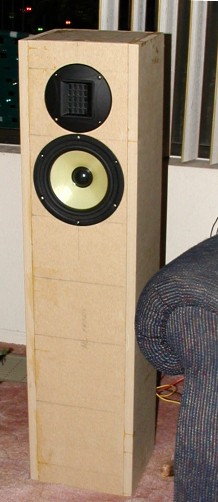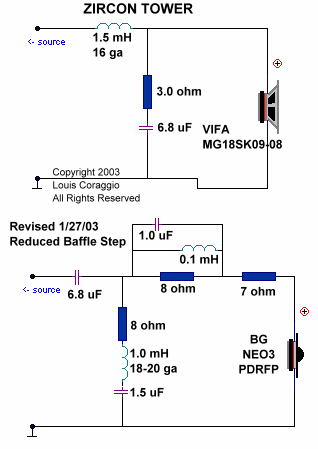
ZIRCON
REFERENCE TOWER
Copyright
2002 © by Louis Coraggio, All Rights Reserved
Last
Update Jan 27,2003![]() Lou's Home Page
Lou's Home Page
Clearance drivers are a great way to learn about crossover design. But they present a problem, they disappear. I wanted to build a high quality system with medium priced drivers that I hoped would be around awhile. While this is still a hobby, I value my time. It seems a bit silly to spend hours refining a design and adding components to $10 drivers. If I'm going to the effort why not do it with better quality components.
I wanted a set of shielded mains that could work with a matching center, using readily available drivers. After much deliberation, I settled on the 7" Vifa MG18SK09-08 and the NEO3PDRFP from Bohlender Graebener. The MG looked attractive for it's versatility, low end and build quality. It should be useable sealed as well as vented. I chose the "S" version of the MG as the specs were the same for both shielded and standard versions.
The NEO3 looked like a lower cost way to try a shielded ribbon. The NEO has a small foot print (for a ribbon) and published specs looked attractive for crossover and response, as it theoretically could go as low as 2000 Hz in a second order crossover.



Box Design and Construction
I first modeled the MG in Unibox. After fiddling, I selected a 24 liter box tuned to 37 Hz. Predicted F3 of 41 Hz. I wanted to do a tower design but given the baffle width required for the driver, I wound up with a shallow box. After much calculation and trial/error I came up with a slot loaded design that gave me a 0.75" X 7.5" X 10.25" port with the net volume required (1500 cu in), adequate depth, and low port air speeds.
I confirmed the Unibox design in LspCad. I then laid out and built the boxes, recessing the MG and surface mounting the Neo. The MG has a thick cast flange that's 5/8" wide. I now have a rabbeting bit that will go to 3/4" so I used it. You may wish to pre-cut the rabbets (before the thru hole) if you want to use the full flange width.
In the box picture you can see the additional 3/8" panel I added behind the speaker cutouts. The Neo requires a rectangular cutout with not much MDF between the screws and corners. Since it's only about 1/2" deep, I left the support panel intact and drilled two small holes to accommodate the tweeter wires. At the top and bottom are pads of imitation Black Hole from PE. The layout shows the top edge of the Neo. Since the cutout is rectangular, it's probably easier to use the gasket that comes with the Neo as a template for marking the cut. I recommend you verify the layout with the drivers before cutting any wood.
Final outside dimensions on my box are 9" W X 8" D X 37" H. About 1500 cu. in. net volume. Because of vertical dispersion, you may consider a different box shape with stands. (See Listening Impressions section) Keep the width at 9" and the driver locations shown.
Since a couple
of people asked, I use a very simple jig for biscuit joining. Use a flat
surface for edge cuts, and a simple jig for face cuts. My Dewalt will
put the slot in the exact center of 3/4" mdf. Can't miss for square,
flush joints.![]() Biscuit
Jig
Biscuit
Jig
Design Process
I set up my testing gear out in the yard. The microphone was set up at 1 meter, on the line between the MG top and Neo bottom. I reasoned that the Neo was really a line source -- not a point source. So using the tweeter axis would be difficult. I did measures of each driver, and the two in parallel. I used a 33 uF cap on the Neo to protect it. Impedance measures were taken with drivers in the box but with out the cap. I also did a nearfield measure of the MG and tried to merge it with farfield for design.
My suspicions about the point vs line source were confirmed when I tried to reconcile the "combined" measure with the two individual measures. No realistic location of the drivers in LspCad allowed me to reconcile the two curves exactly. Based on physical measurements I took my best guess and began design work. I use merged response only for baffle step confirmation. While the farfield measure looks ragged, it matches up fairly close with LspCad's prediction for in room response using only the baffle and ground effects. I've gotten used to using the farfield so I can compensate for the raggedness by eye. For the Zircon, I used a target curve that includes the BBC dip with a slightly depressed high end.

